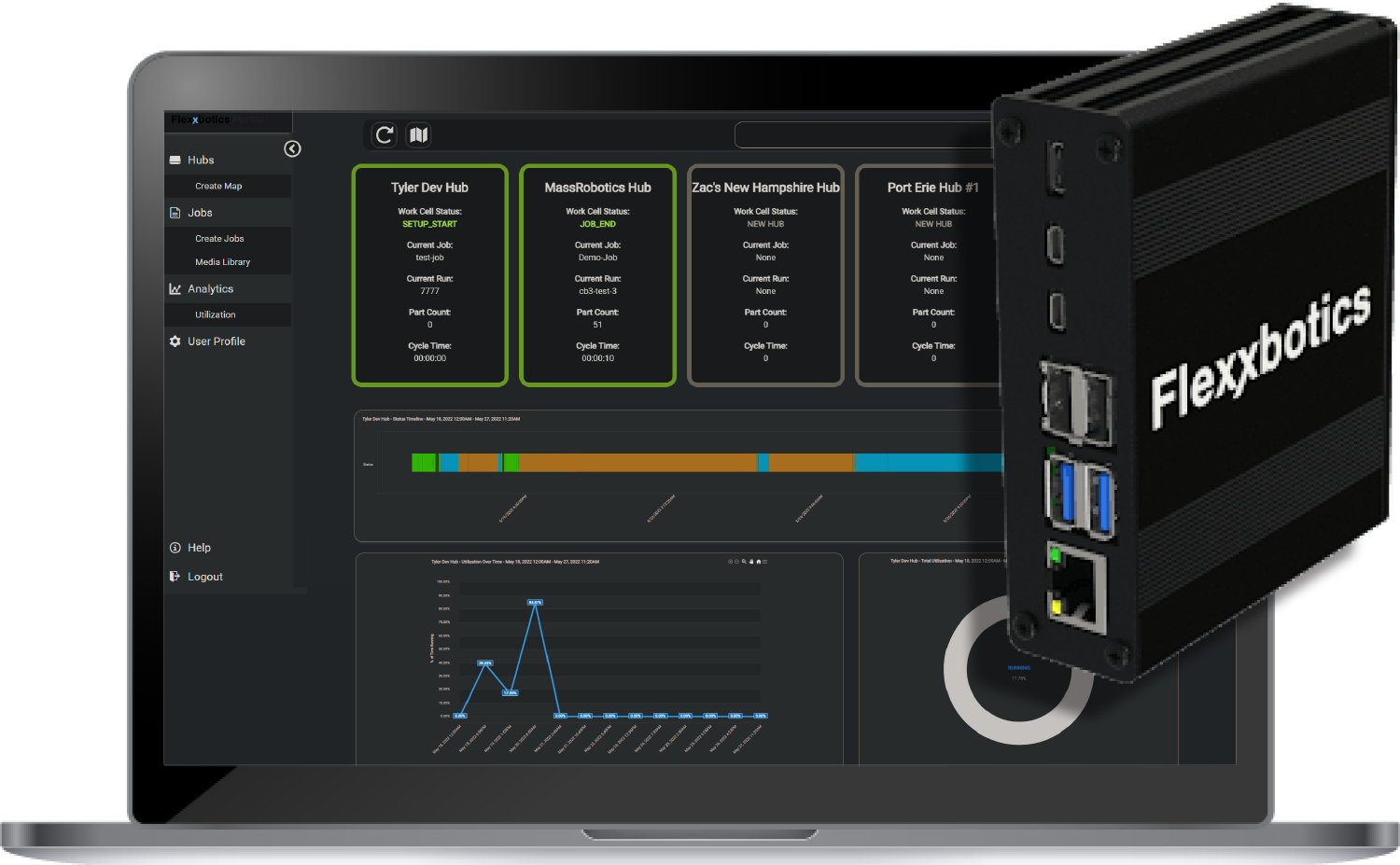
By: Flexxbotics, June 2022
Optimizing Work cell Management
for Lean Manufacturing
A manufacturing work cell is a group of people and equipment that manufacture a product or part. This approach, also known as cellular manufacturing, is a popular starting point to improve efficiency and productivity in discrete component manufacturers. This lean manufacturing concept reduces the waste and costs inherent in manufacturing.
It sounds like a simple idea—put all the things and people required in the same place. But in reality, organizing, optimizing, and managing a manufacturing work cell is complicated. Manufacturing work cell management requires a deep understanding of all the processes involved. It also requires adaptability to cope with changes in the product, the machinery, and the people involved.
For many years cellular manufacturing was only used by large companies with huge capital investment budgets and extensive internal expertise. But the costs and complexity of new technology and digital infrastructure have come down, opening the door to mid-sized manufacturers.
Every company can buy the newest equipment. But to achieve an aggressive return on investment (ROI), you must always be optimizing these manufacturing work cells. This requires a deep knowledge of the products and processes.
Hunting Waste to Add Value
In a lean manufacturing environment, waste is anything that doesn’t add value to the product or the company. It’s organized into seven categories: Overproduction, inventory, motion, defects, overprocessing, waiting, and transport. Most companies trying to optimize a manufacturing work cell have probably already eliminated the waste that’s easy to find.
Let’s uncover the potential hidden waste in all seven categories:
Overproduction
This is first on the list because overproduction is potentially the most damaging of all forms of waste. It can be caused by many factors, such as poor planning or workers trying to hit a quota for their shift without demand for all the parts being produced. Overproduction causes other wastes, such as transporting goods that aren’t needed, increased inventory costs and keeping workers from performing other value-added or waste-reducing tasks.
Inventory
Space on the shop floor is a valuable asset. If you are using it to store finished products that don’t actually have a buyer, you can’t use that space to add value to your company. High inventory levels also require more man-hours to manage and run the risk of damaging products before they get shipped.
Motion
Wasted motion is the silent killer of the bottom line. Does a machine operator need to walk across the shop floor to get new tooling? Save that wasted time and keep the required tooling beside the work cell. If a work cell is set up in a way that requires numerous repetitive movements to complete the operation, try to optimize the set up to reduce that movement. Remember: even a few seconds adds up over the course of a shift, meaning the worker will produce more during that shift. It also reduces worker fatigue, making them more productive.
Defects
Defects are pure loss, which is why many automotive and aerospace suppliers strive for a zero-defect production cycle. Defects waste raw material, machine time, tool life and wear-and-tear on the worker and machine. They also have to be stored until they are disposed of, taking up space and requiring transportation from the work cell. None of this adds value for the customer.
Overprocessing
Adding extra steps to production as a safeguard against mistakes is a classic way to reduce profit margins for that part mandate. Whether it’s added paperwork to reduce back office problems or too many quality checks in the process, it all adds up to a work-around rather than addressing the actual problem that required the extra steps in the first place. Plus, extra steps are just another opportunity for mistakes to happen.
Waiting
Waiting is another type of waste that can impact the entire factory. Usually caused by poor inventory management or bad job scheduling, having workers wait by an idle machine smothers any other attempts to boost efficiency. Time spent waiting ripples through the entire plant, costing you money every step of the way.
Transport
This waste is similar to motion, but focuses solely on the movement of the part through each process. It also covers how a worker programs his machine for each task. Many companies suffer from extra transport because of how the floor is organized and how job data is input on the machine.
Bonus Waste: Skills
Any company suffering from the seven common wastes is going to have another problem on their hands: low morale. Each of these wastes has a significant impact on the workforce, ranging from fatigue to frustration. Tired and frustrated workers are unlikely to give their all and are more prone to absenteeism, all of which costs the company. And the expense of hiring and training to deal with high-employee turnover can be substantial.
Connect the Office to the Manufacturing Floor
FlexxConnect™ is a digital platform that connects business systems and manufacturing systems. It combines data from both systems to create a single source of truth. Making it easier to improve the process and achieve true lean manufacturing success. This combination of office and shop floor data delivers valuable insights that can improve profit margins and increase competitiveness.

Our Solutions to Waste

Over Production
Digital flow of information directly
from the work cell to the office.

Inventory
Work cell data aids planning
and reduces overproduction.

Motion
Automate work cell setup and
reduce movement to and from
your work cell.

Defects
Utilize guided process control
to reduce defects and scrap.

Overprocessing
Identify & eliminate non-value-
added steps in your process
through setup automation.

Waiting
Combine task-specific views to identify and remove bottlenecks.

Transport
Digitally send job information
directly to the work cell.

Bonus Waste: Skills
Eliminated waste leads to
an engaged, proud team.
Empower Lean Work Cell Optimization
A focus on eliminating waste and continuous improvement is part of the DNA of any company committed to lean manufacturing. With FlexxConnect™, medium-sized manufacturers can empower their employees and managers to reduce waste. You can then continually add value to your processes without needing the army of lean experts used by large manufacturers.
If you are looking to increase the efficiency and ROI of
your machinery and equipment, FlexxConnect™ can help.
Reach out and book a demo today.
